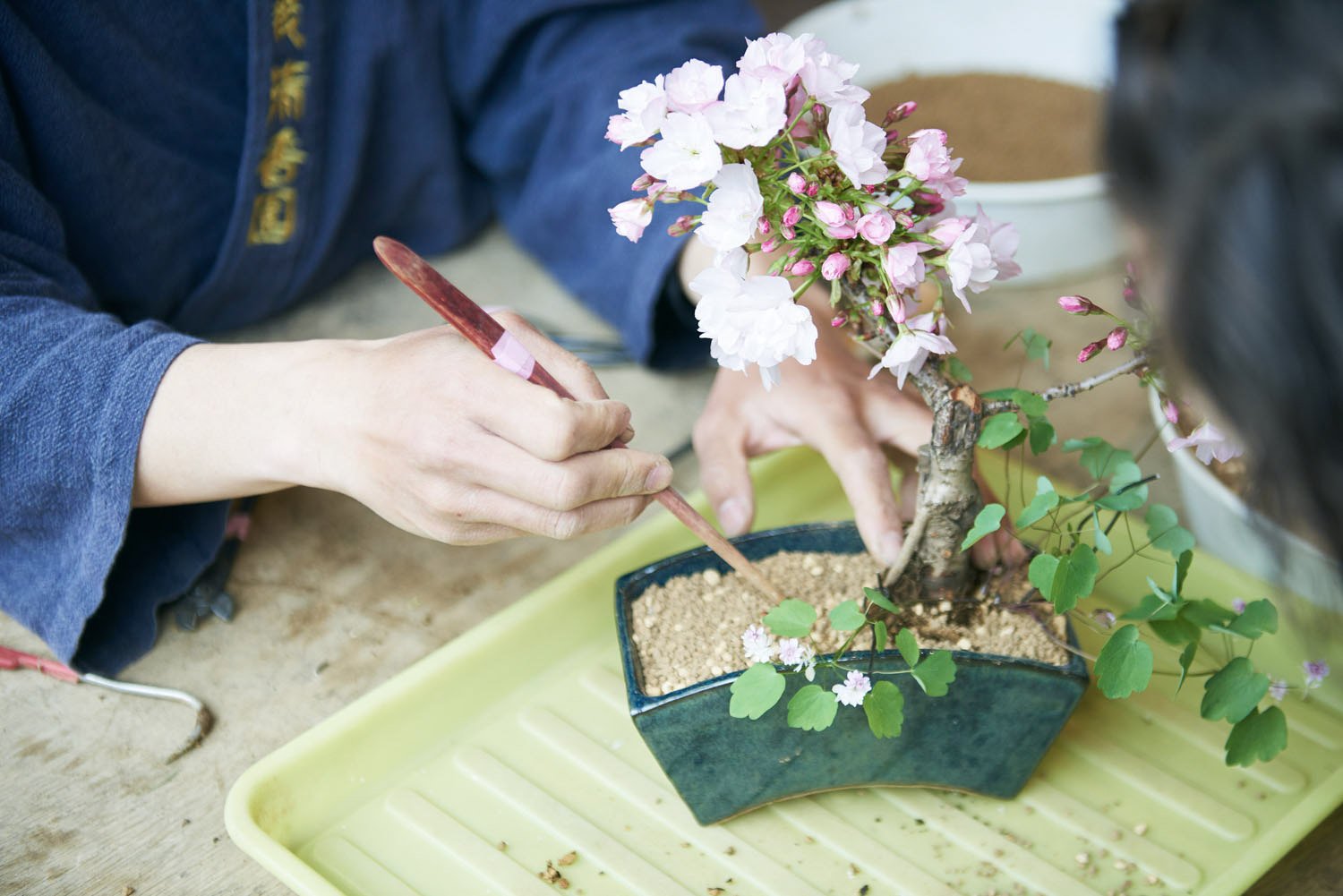Poem and a Picture: Japanese Gardens as Reflections of the Natural World
By David McElhinney
At a glance, Japanese gardens are instantly recognizable. A solitary pine tree. Perhaps a weeping cherry in one corner or a thicket of plum blossoms in the other. A pond underneath a crescent-shaped bridge. Stone lanterns green with age and gently rolling mounds of grass. A heron perched upon a rock and the glug of a shishi-odoshi (bamboo fountain). A contemplative space, where it is implicitly understood that less is somehow more.
But as is the way with Japan’s traditional artforms, Japanese gardens prove difficult to define. Rather than strive for an ideal of beauty, garden designers aim to recreate the essence of a real-world landscape in miniature form, abhorring overly symmetrical design and brash floral displays. They achieve this by using the building blocks of the natural world: rocks and stones to represent mountains or islands, raked gravel to symbolize rippling water, carpets of moss that evoke vast grasslands, and plants and trees to show the passing of the seasons.
Take a tsubo-niwa, a quasi-indoor garden that might comprise a space no larger than a pair of tatami mats, or a bonsai display illuminated within a tokonoma alcove. Despite their diminutive sizes, they impress upon the viewer a sense of something grand, as though they are sprawling vistas condensed into their most compact and comprehensible forms.
But how the components of a garden are used, and to what scale, is left largely to the whim of the garden architect. And the lack of clear definitions of form and content means each viewer will see the garden differently.
Lafcadio Hearn, one of the great cultural interpreters of life in rural Japan during the Meiji era (1868-1912 CE), understood the elusive beauty of Japanese gardens. In his lengthy but eminently readable paean, In a Japanese Garden, he discussed the tones and values of stones shaped by nature, the folktales and superstitions concerning garden shrubs, and the frogs whose croaking was an omen of summer rain. He also implicitly understood the message a Japanese garden ought to communicate.
“No effort to create an impossible or purely ideal landscape is made in the Japanese garden,” he wrote. “Its artistic purpose is to copy faithfully the attractions of a veritable landscape, and to convey the real impression that a real landscape communicates. It is, therefore, at once a picture and a poem; perhaps even more a poem than a picture.”
And it is poetry of the purest kind, where the rhythm and beat is created not with words, but with the elements of the world itself. There are many fine examples of this, chief of which is the garden at the Adachi Museum of Art in Shimane Prefecture. Though in reality it is a combination of five gardens - dry landscape, moss, white gravel and pine, pond, and the Kikaku Waterfall - it has been voted the most beautiful garden in Japan for more than 20 years in a row by Sukiya Living, a US-based magazine also known as the Journal of Japanese Gardening.
The shrubs, jagged stones, humps of trimmed grass, and pruned trees in the dry landscape garden rise like landforms, and appear as extensions of the mountainous backdrop. The technique employed here is called shakkei, meaning “borrowed scenery,” which uses the natural surroundings to increase the sense of beauty and scale. Elsewhere, moss grows in thick, furry clumps - cultivated in the Kyoto style - which imbues the garden with wabi sabi imperfections. The white gravel and pine garden, inspired by the ukiyo-e (woodblock prints) of Yokoyama Taikan housed within the museum, unfurls across the landscape; a scattering of pine trees rising from a coastal dune system. In the pond garden, signs of life are scattered among the otherwise still scenery: a teahouse, where guests drink sencha and gaze out at the carp-filled pond.
But the waterfall is the most inventive addition. Constructed on the face of Mt. Kikaku, 100 meters away from the perimeter, it appears drawn in from the viewing room, as though within touching distance of the pines at the garden’s edge. Much like the paintings that inspired the museum’s founder, Adachi Zenko, the garden is a combination of multiple different perspectives that create one seamless image. Zenko thought of it as a “living painting;” one that changes face as each season segues into the next.
The Adachi garden is evidence of a common theme in Japanese gardens - those that were inspired by artists, who in turn were inspired by the world around them. Rikugien in Tokyo’s Bunkyo ward, one of the capital’s finest daimyo gardens, similarly draws inspiration from this nexus where art and nature meet. Constructed around the turn of the 18th century, under the stewardship of feudal warlord Yoshiyasu Yanagisawa, the garden was designed to reflect 88 scenes from six classic waka poetry divisions - Rikugien translates to the “Garden of Six Poems.” Only 32 of these depictions remain among the jostle of zelkova, maple, and cherry trees, but their symbolism hasn’t lost any potency.
Spirituality binds art and nature together, so Japanese gardens tend to mirror mythic narratives and revel in heavenly imagery. In the center of Rikugien is Naka-no-shima, an island surrounded by a large pond. It hosts Imo-yama and Se-yama, the “man mountain” and “woman mountain,” two mounds covered in snooker-table grass that appear as viewing points towards a distant horizon. They symbolize Izanagi and Izanami, a pair of gods central to the Shinto creation myth. On the northern side of the garden, visitors stroll over Togetsukyo, a stone bridge designed to look like the moon passing through the sky. And from the pond’s southern tip, Horaijima comes into focus. The small stone island represents the paradise of Horai, the land of immortals, a frequent object of artistic desires.
Kyoto - or at least the Kyoto that once was - owes much of its fame to this worldview as well. “The city is profound,” an expert on Japanese gardens recently told me. “All these tourists come here because they are interested in Eastern philosophy, and Kyoto’s gardens are physical manifestations of that philosophy.”
In the introduction to Zen Landscapes, author Alan S. Weiss discusses a visit to Ryoan-ji, a karesansui (dry rock garden) in Kyoto, where he stood “stupefied” by its “sublime beauty.” The garden is the ultimate exercise in creative minimalism, but holds a much deeper complexity. A courtyard of earthen walls, 15 rocks on beds of moss scattered across a patch of gravel, and a rectangular plot of pebbles. That’s all there is to it. The meaning, however, is not so easy to ascertain. The rocks are arranged in such a way that viewers can never see all 15 at once, as though the number itself is sacrosanct.
The stillness of the garden suggests it was created to embody the principles of Zen, but some argue it depicts a tigress carrying her cubs across a pond, or islands floating on a vast ocean, or a representation of Japan in its embryonic stage of creation as described in ancient texts. What one gleans from Ryoan-ji’s design is ultimately down to perception; chances are, no two viewers will see it the same way. This is the very essence of a Japanese garden: it is both art and nature, both poem and picture, both open to interpretation and profoundly simplistic.
Renowned Japanologist Alex Kerr noted in his seminal book, Lost Japan, that his adopted homeland was “fascinated by secrets” - from the techniques of bonkei (miniature landscape art) to the imperial regalia concealed within Ise Shrine to the mandalas (diagrams of spiritual truths) in Esoteric Buddhism. Like the world they reflect, Japanese gardens conceal secrets, too: every stone and tree is wrapped up in metaphor, every landscaping feature is rooted in symbolism. So perhaps only by revisiting a Japanese garden, by studying its form and contours, and contemplating its true meaning, can you begin to understand what those secrets are.
About the Author: David is a Northern Irish freelance journalist, writer and occasional editor based in Tokyo and the UK. Fusing reporting and social commentary with extensive experience traveling throughout the country, he has published stories on travel, arts and culture, politics and current affairs, and sports in Japan. His work has appeared in a range of national and international publications online and in print. You can find links to his work at www.davidmcelhinney.com.









